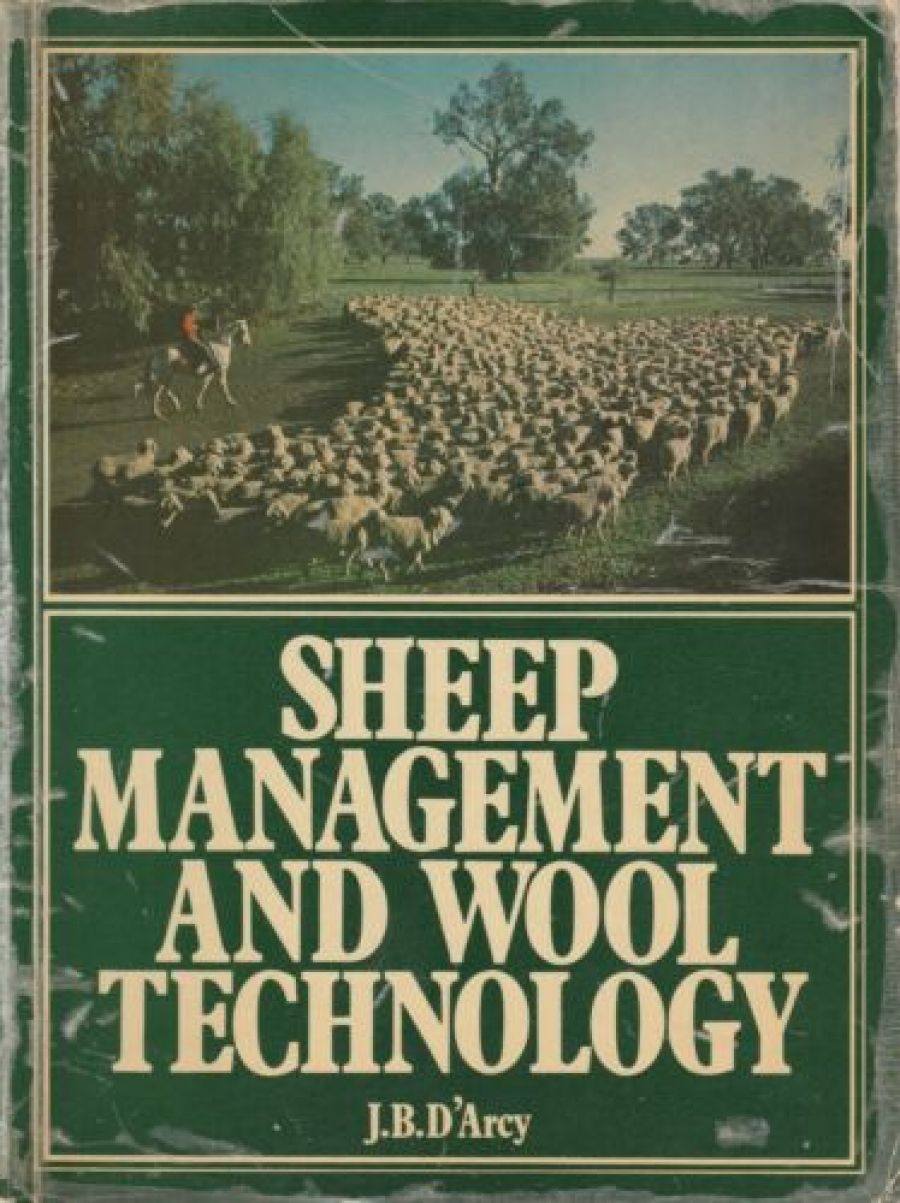
- Free Article: No
- Contents Category: Non-fiction
- Review Article: Yes
- Article Title: Confused Advice
- Online Only: No
- Custom Highlight Text:
You will never guess from reading these two books that Australia is generally regarded by the rest of the world as the best place to seek information on scientific sheep management and efficient wool production.
For more than thirty years Australian scientists have successfully led the search for a better understanding of the biological workings of a sheep, the structure and growth of wool fibres and of the ecological intricacies of pasture management. During the same period wool technologists have made tremendous strides in the preparation, handling and measurement of wool, while economists have made their own important contributions to the more efficient management of sheep and the more efficient marketing of wool.
- Book 1 Title: Sheep Management and Wool Technology
- Book 1 Biblio: NSW University Press, 324 pp., illus., $12.95, 0989465169
For more than thirty years Australian scientists have successfully led the search for a better understanding of the biological workings of a sheep, the structure and growth of wool fibres and of the ecological intricacies of pasture management. During the same period wool technologists have made tremendous strides in the preparation, handling and measurement of wool, while economists have made their own important contributions to the more efficient management of sheep and the more efficient marketing of wool.
Indeed, the literature on Australian sheep and wool is so vast and detailed that it is a brave person who attempts to review it and tries to sort out the practically important from the purely theoretical. However, difficult though the task is, there is no excuse nowadays for not attempting it and for ignoring most of what has been published in the scientific and professional literature in favour of an out of date re-hash of miscellaneous facts and prejudices which add little or nothing to what has gone before.
The most surprising feature of J. B. D’Arcy’s Sheep Management and Wool Technology is that it has now passed into a second edition. One can only assume that students of wool classing in technical schools still follow a traditional and out-dated curriculum that is well accommodated by this test. Even so it is surprising that the publishers did not take advantage of the new edition to make some elementary and much needed changes. For example, an index would have greatly improved the book’s usefulness to students (or to any other reader for that matter).
More seriously, the contents lack a sensible balance and a logical order of presentation. It is strange to find only eight pages devoted to ‘Australian and New Zealand Breeds’ and 14 pages to ‘The Australian Merino’, while twenty-three pages discuss ‘British Breeds of Sheep’. It is particularly disconcerting to find as much space allocated to ‘The Scotch Black Face’ (which is not found in Australia) as to the section on ‘Choosing Drought Rations’. One wonders what the reader, who needs to be told that ‘wool is a protein – a group of chemical substances which include meat and many other animal products’ can make of illustrations of ‘helical polypeptide chains’ which constitute ‘protofibrils’.
There would seem to be an overwhelming argument for altering the order of chapters so that, for example, the reader learns about the ‘Anatomy and Physiology of Sheep’ before coming to those sections which deal with nutrition, breeding, pregnancy, lambing and management. So much in the book seems to have been collected and assembled without sufficient thought being given to the relationship of one section with another or to the overall needs and interests of the reader.
The strength of the book lies in those sections which deal with the ‘traditional aspects of wool classing, preparation and processing, and the details of wood testing (including 58 pages of quotations from the Core Test Regulations of the international Wool Textile Organisation), but these sections will have limited appeal for the reader who is more interested in sheep management than wool technology.
It is curious to reflect that the Press of the University of New South Wales, which has its own reputable School of Wool and Pastoral Sciences, should have published this undistinguished text.
Raising Your Own Sheep by Geoff Nash is an unpretentious little book that claims ‘to answer the questions of those starting to raise sheep in Australia.’ The main questions it seeks to answer are those asked by hobby or weekend farmers who intend to keep a small number of animals, often for the production of white or coloured wools for home-spinning. Given complete ignorance and a desire to read only the simplest statements in the simplest style (‘Rams are nice when young, but they can be evil-tempered when fully grown.’ ‘As long as you keep your sheep healthy and well fed, they will grow a saleable crop of wool each year.’ ‘Sheep make excellent pets.’) Readers will find this a helpful little book. The drawings which illustrate this review are taken from the book and reflect the levels of insight and complexity found in the text.


Comments powered by CComment